In-App Messaging: The Complete Guide For Mobile And Web Apps
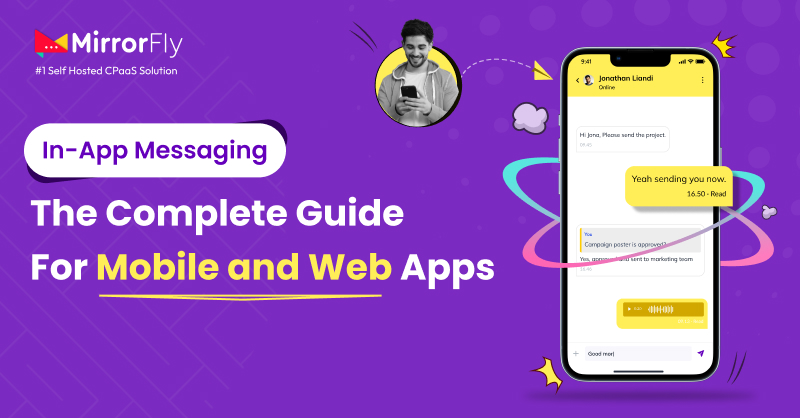
As a business owner, did you miss out from sending real-time updates and personalized offerings in your mobile or web app? Then, don’t get shocked if you have less customer engagement and retention.
Why I say this is, in-app messaging has become a must-have for businesses. Braze’s study says, businesses have witnessed a 131% increase in user engagement rate with in-app messages. This clearly shows how important in-app messaging is.
And, now you may have several questions in mind regarding the development cost, time, their benefits, use cases, top API providers and more.
In this blog, you will get answers to all of them. This would be your ultimate guide to in-app messaging for mobile and web apps. Let’s get started.
Table of Contents
What Is In-App Messaging?
In-app messaging is targeted messages that users see while actively using a mobile web or app. These messages cannot be opted in or out, but can be dismissed. Below are a few examples of what an in-app message provides to users:
- New Feature Announcements
- Guide Onboarding Users
- Welcome Messages
- Tooltips
- Product Update Information
- Feature Promotion
- Special Offers/Promotions
- Customer Satisfaction Surveys
- Transactional Messages
Ultimately, this in-app communication increases user experience and engagement. Reckless research says, “In-app messaging achieves 75% open rate, which is 3x times higher than push notifications and 45x times higher than email.”
What’s The Difference Between In-App Messages And Push Notifications?
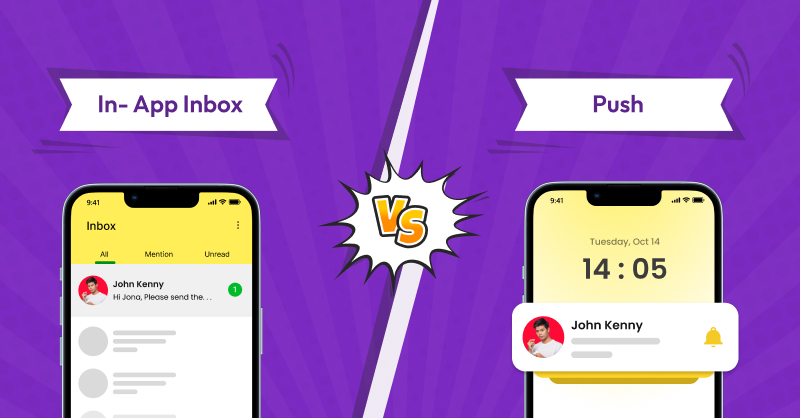
In-app messages are usually confused with push notifications. In simple words,
- In-app messages are displayed inside the app.
- Push notifications appear on the user’s device even when they are not using it.
| Factors | In-App Messages | Push Notification |
|---|---|---|
| Objective | Guide and engage with active users | Re-engage with users who are not active |
| Permissions | Cannot be disabled | Can be disabled at any time |
| Placement | Inside the app | Outside the app (lockscreen or notification tray) |
| Format | Banners, tooltips, checklists, surveys | Short notifications |
| Impact | Can enhance the user experience | Can stress the users if sent frequently |
| Customization | Based on in-app user behavior | Based on user profiles and past interactions |
Why In-App Messaging For Your Business?
When you use in-app messaging, you’re telling the customers that ‘you care about them and understand their needs’. Enterprises can build trust and loyalty with their customers.
- Improve Engagement Rates: In-app messaging captures users’ attention and results in a high engagement rate
- App Opening Frequency: Providing valuable content and promos makes the users open the app more frequently
- Trigger Immediate Action: As messages are seen by active customers, immediate action is taken
- Guiding The Audience: Help users understand your app and reduce the chance they abandon it after one use
- Personalize the Experience: By targeting specific user segments with relevant content, in-app messaging personalizes the customer experience
- Educate Users On ‘How To Use’: Highlighting product key features and encouraging users to try them increases product adoption rates
- Increase Customer Value: Promotes add-ons, upgrades, cross-selling other products to existing customers
- Retains Customers: By helping customers find value in the product, in-app messaging retains and improves customer lifetime value (LTV)
- Contextual Upselling: When a user reaches an account limit or interacts with a premium version feature, in-app messages help in upselling
- Build Customer Loyalty: Discounts and promotions are announced through in-app messages
- Minimize Customer Loss: Proper in-app messages and exit surveys may stop users from cancelling their subscription
- Frictionless Communication: Users can send inquiries within the app to contact an agent directly. For enterprises looking for complete control, a self-hosted chat solution lets them manage conversations securely within their own infrastructure.
What Are Some Common Types Of In-App Messaging?
Different types of in-app messages used in mobile web and apps differ based on their purpose. These messages guide users, make announcements, collect feedback, and more. Let’s see them one by one.
1) Modals/Pop-ups:
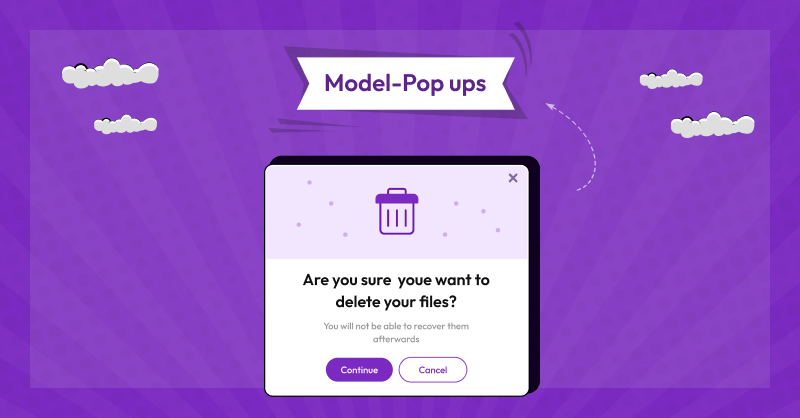
Modals appear in the center of the screen and capture user attention. They can be overlay or a pop-up window that blurs the background to focus on your user’s attention. It’s triggered when your user performs a specific action, for example, adding a product to the shopping cart.
Use Cases: Welcome screens, new feature announcements, release notes, and onboarding gamification.
2) Banners
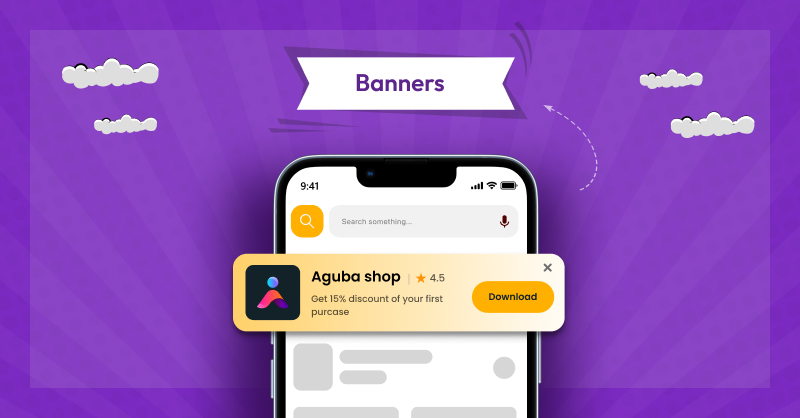
Banners appear at the top or bottom of an application’s screen. Less intrusive than modals, and allows your users to continue interacting with the app. It is displayed contextually, delivering the right message to the right user at the right time. Usually comes with a call to action (CTA) button and lets users tap on it.
Use Cases: Special offers, system status updates or cookie policy consent.
3) Tooltips
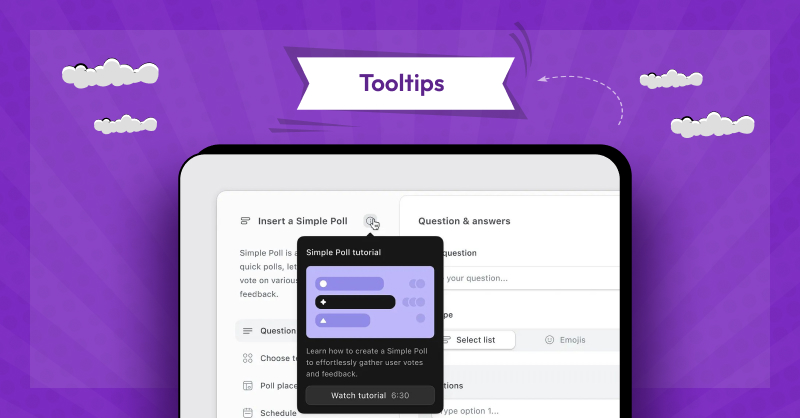
Tooltips are text boxes appearing when your user hovers over a specific icon. They guide users on how to use a feature and make it more discoverable. It doesn’t overwhelm them with too much information at once.
Use Cases: Providing quick explanations or clarifications without messing up the interface.
4) Product Tours
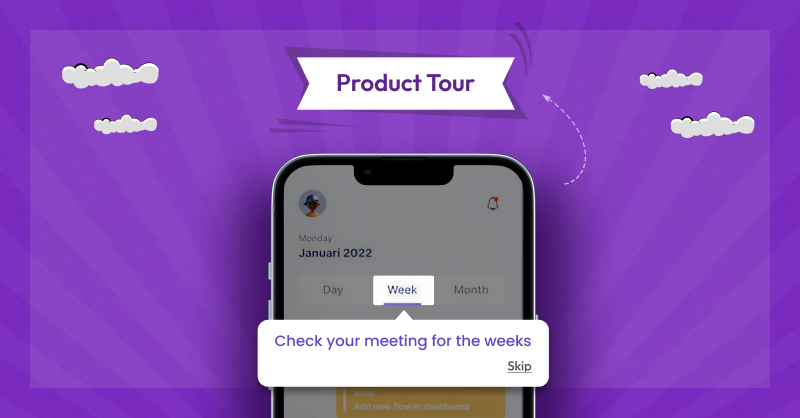
New users explore the product alone. Product tours guide new users with key features & functionalities. It comes in multi-step and can turn new users into active ones.
Product tours contribute to long-term retention of your users, as they may stay if they understand how to use a product.
Use Cases: User onboarding process and new feature announcement.
5) Surveys
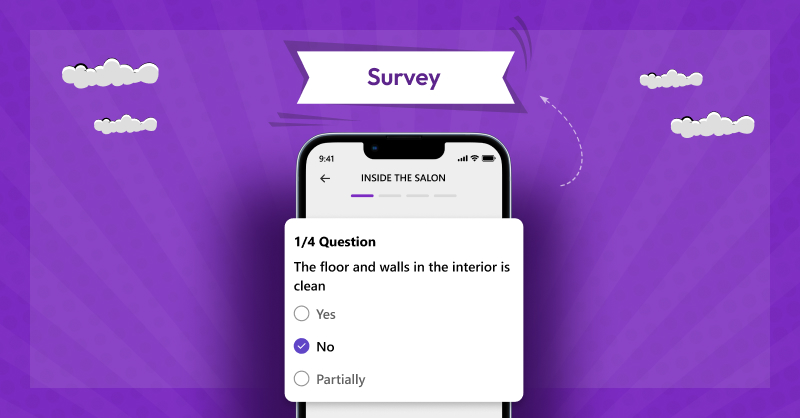
Surveys collect valuable user feedback directly within the app. After your user completes an action, these surveys are triggered. The response rate is high because it appears very shortly. They are seamlessly embedded into the app, so that your user workflow isn’t disrupted.
Use Cases: Measure sentiment or collect user feedback
6) Chatbots
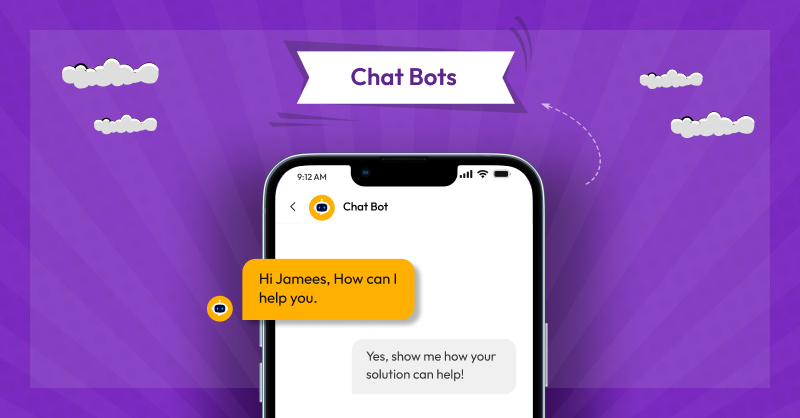
It provides real-time chat support by answering frequently asked questions or giving contextual tips based on your customer behavior. Streamlining customer service or managing large volumes becomes easier.
Using AI and NLP technologies, these chatbots handle FAQs, manage appointments, guide your users, and offer product suggestions.
Use cases: Marketing & sales, Customer service support
7) Interstitial Messages
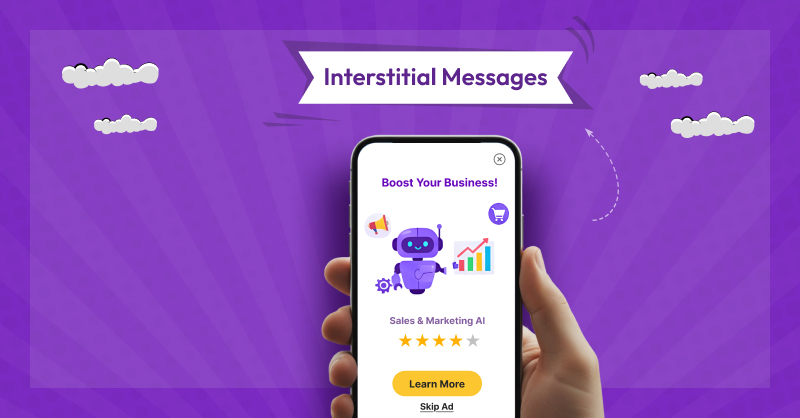
You can’t ignore interstitial messages as they are full-page pop-ups. Either you close it or take action. They appear when your users naturally transition within the app for less duration.
Interstitials are usually sent to specific user segments. They may include rich media elements such as images, videos, text, or clickable buttons.
Use Cases: Inform main feature updates, important announcements, promotional offers, or ongoing maintenance.
8) Slideouts
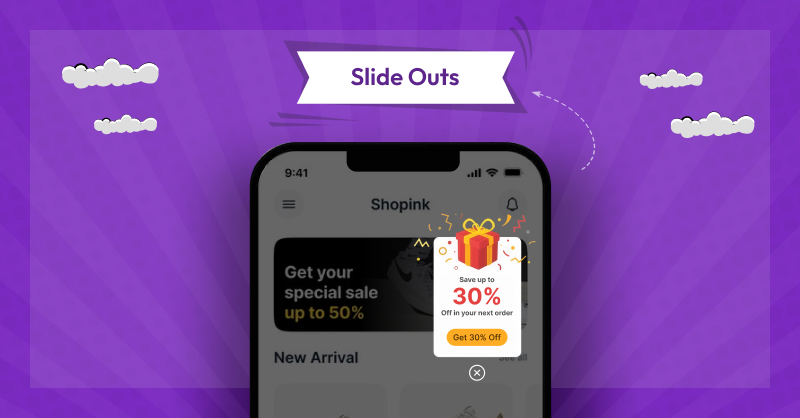
Slideouts emerge from the edge of the screen (left, right, top, or bottom) over the main content. Other names for slideouts are drawers or sidebars. It doesn’t interrupt your user’s primary task. Usually dismissed by swiping or by clicking a “close” button.
Use Cases: Delivers contextual messages that can be feature announcements, feedback requests, or quick tips.
What Are The Use Cases Of In-App Messaging?
New users look for guidance, existing customers may expect new features and discounts occasionally. On the other hand, business owners look for feedback to improve customer experiences and retention.
And, in-app messaging bridges all these gaps. In the table below, we have listed the common use cases and most applicable industries.
| Use Cases | Most Relevant Industries |
|---|---|
| New User Onboarding: Imagine a user didn’t understand the product interface immediately after onboarding. They would get frustrated. In-app messaging helps users learn its functionality. In SaaS, in-app messaging helps users understand with product demos and customization assistance. | SaaS, Banking |
| Feature & Product Adoption: In-app messaging encourages users to try and adopt key features of the product. Targeted announcements, educational walkthroughs, customized feature tours and tooltips are some common strategies to make the user explore new and unused tools within an app. | Healthcare, E-commerce & more |
| Announcing Updates & Offers: Modals, tooltips and banners keep users informed about the new updates and limited-time offers. | Super-Apps, E-commerce |
| Collecting User Feedback: In-app surveys gather feedback directly from users while they are engaged with the app. | Social & Community App, Travel |
| Account Expansion & Revenue: In-app messaging can generate more revenue from existing customers by providing them with more value. Advertising premium features within the app or providing contextual messages can trigger users to upgrade their plans. | Gaming, Streaming App |
| Customer Service: Chatbots present within a company’s mobile or web app offer 24/7 instant customer support. | Telecom, Healthcare and more |
Top API & SDK Providers For In-App Messaging, In-App Chat
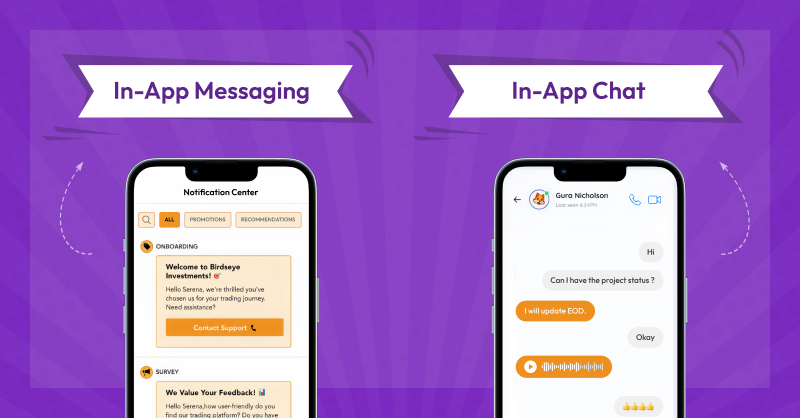
Before we look into the top in-app messaging and in-app chat API & SDK providers, let’s clarify the difference between them.
- In-app messaging is a one-way communication from app to user. The primary purpose is marketing and product guidance. Includes pop-up modals, tooltips, banners, checklists, surveys and more.
- In-app chat is a two-way communication from user to provider. Customer support & service are its primary purpose. Here, the chat interface allows text, photos, and voice messages.
In short, in-app messaging is essential for customer engagement and in-app chat for real-time customer support.
To deliver a seamless experience across devices, providers offer native SDKs separately for Android and iOS. Curious to know the top providers? Let’s see.
Top Android API & SDK Providers in 2025
Top Android in-app messaging and chat API & SDK providers are MirrorFly, Sendbird, CometChat and Apphitect.
1. MirrorFly – Best In-App Messaging Solution
MirrorFly is one of the best chat API solution providers. MirrorFly Android chat API & messaging SDK helps businesses add live chatbots and voice chat to any Android app. This secure solution uses advanced NLP & NLU to understand context, remember past conversations with your app users, and respond naturally.
It’s applicable across banking, healthcare, social & community, SuperApp, and SaaS businesses. MirrorFly’s API lets you build a chatbot that can be trained on your own data and gives output based on your brand’s tone.
Embedding this solution into your existing app is easy, and you can go live in less than 48 hours. With 1000+ pre-built features, MirrorFly remains a top choice for businesses.
Best for: enterprises looking for a completely customizable messaging SDK.
Features:
- Whitelabel Solution
- Real-Time Messaging
- Voice Call
- Topic-based Chat
- Data Ownership
- Custom Security
- Activity Feeds
- Live Streaming
- SIP/VoIP Solution
- Flexible Hosting
15 Reasons To Choose MirrorFly:
Complete Data Ownership: Take full control of your app’s infra and security AI-Powered Features: You get smarter and more personalized interactions in your app with the AI features White-Label Capabilities: Get your brand identity on your app by adding your brand’s font, element, logo, color and theme Flexible Hosting Options: Deploy your app in your own data center or cloud or on MirrorFly’s dedicated cloud server Full Source Code Access: You can add, modify and remove any features from the solution as you prefer 1000+ In-App Features: You can fully customize your app with MirrorFly’s 1000+ features Free Migration & Integration Support: Easily migrate your existing setup with MirrorFly with zero downtime. We guide you throughout the transition 8+ Production Ready AI Agents: MirrorFly has intelligent chat, voice and video agents tailored to your use case Dedicated Developer Team: You can hire a team that builds, launches and maintains your app as you want Multi-Tenant Architecture: Supports ‘n’ number of your clients from a single solution 15+ SDKs: MirrorFly’s SDKs are developer-friendly and integrate effortlessly into your app Custom Security: You can safeguard your app with custom security encryption & privacy regulation, as each app is unique and needs to be protected in different ways SIP/VoIP Solution: You can connect users via voice calls on internet-enabled devices Scale 1 billion Conversation: Handles 1 billion+ active users without any glitch Compatible with 100+ Integrations: You can easily integrate 100+ third-party plugins into your app |
2. Sendbird – #1 In-App Communication Platform
Sendbird’s messaging API integrates easily with your stack to send automated messages. You can craft, customize, send, and track messages for key use cases. Omnichannel messaging, moderator messaging, advanced analytics, and call studio are some features that Sendbird offers.
The company was built in 2013 and has 300 million+ monthly active users. Won “Best in Communications APIs” award by API World.
Best for: applications in gaming, marketplaces, social networking, and customer support.
Features:
- Send omnichannel updates
- Orchestrate channels & timing
- Custom notifications
3. Cometchat – Leading In-App Messaging API
Cometchat lets you deploy production-ready notifications in minutes with flexible providers and smart delivery rules. The UI-focused approach reduces development time by 60-80% resulting in minimal SDK dependency. You can save on a monthly subscription while accessing superior features. It comes with a demo app to showcase the latest UI kits.
Best for: building social media platforms and e-learning apps.
Features:
- Lightning-Fast Messaging
- Rich Media Support
- Typing Indicators
4. Apphitect – Next-gen Android In-App Chat API
Apphitect is a white-label solution, you have all the control over the data, security, and infrastructure. Every interaction with the chatbot is protected by enterprise-grade encryption and global compliance standards, including GDPR and HIPAA.
This fully customizable chatbot solution gives you complete data ownership and full source code access. Developers can choose flexible hosting on their own servers or the Apphitect cloud.
Best for: businesses that need an intelligent in-app messaging API
Features:
- Export Chat
- Custom Security
- Typing Indicator
- Group Voice Call
- Topic-Based Chat
- Image Attachment
- Data Ownership
- Source Code Ownership
- Customizable Workflow
- Upload Media Message
iOS API & SDK Providers
Top iOS in-app messaging and chat API & SDK providers are Crisp, Stream, Firebase and Sendbird.
1. Crisp – Secure In-App Chat API Provider
Crisp was built in 2015 & 100% bootstrapped. The headquarters are located in France and connect 6M+ users worldwide. With Crisp, customers get notified when a message is left unseen through the built-in push notification system.
It supports instant leads and customers with a chat widget. The chatbot delivers messages to meet customers’ needs and you can get 20% more conversations with proactive messages.
Best for: businesses that prioritize cross-channel communication
Features:
- Enterprise-level security
- Chat customization
- Custom LLM
2. Stream – Top-rated In-App Chat SDK
Stream has feature-rich SDKs and a highly reliable chat infrastructure. Stream supports 5M+ users in a single channel and 99.999% uptime SLA. It improves overall in-app conversion, engagement, and retention.
Some notable features available are AI text & image moderation, a dedicated AWS region stack, shared Slack channels, and audit logs.
Best for: building social networks and apps.
Features:
- Low-level clients & backend SDKs
- Pre-built UI components
- Custom messages, events & metadata
3. Firebase – Scalable iOS In-App Messaging Solution
Firebase is a comprehensive Backend-as-a-Service (BaaS) platform by Google. It lets you send targeted, contextual messages for app discovery. The company was founded in San Francisco in 2011 and was incorporated in Delaware.
Developers can spend less time on the backend applications, as it allows them to focus on user experience and feature innovation.
Best for: developers and startups looking for real-time features.
Features:
- Get performance insight
- Design customization
- Behavior and interest-based messages
4. Weavy – Trusted In-App Chat Platform
Weavy provides secure chat and messaging solutions with end-to-end encryption, ensuring compliance with regulatory standards. Core feature includes 1-to-1 & group chats, file sharing and built-in meetings. Also, this platform supports context-aware conversations and automated workflows.
Best for: developers adding AI-powered chat to their apps
Features:
- Scalable workflows
- Enterprise-ready features
- AI model access
How To Choose The Right In-App Messaging Platform?
What if the platform you choose causes challenges along the way? Complications with integrating, less scalable, security risks and poor user experience. That’s why selecting the right one matters the most. Here is a step-by-step guide on how to choose the right in-app messaging platform
Step 1: Define Your Primary Goals & Use Cases
Before you proceed to evaluate any platform, clearly define what you want to achieve with in-app messaging. This will help you select a provider that suits your needs.
Your main purpose of implementing in-app messaging can be any of the below:
- Personalizing the onboarding process
- Promoting upgrades or add-ons
- Offering on-demand help within the app
- Encouraging users to try key features
- Ensuring users continue with your product long-term
The in-app messaging use cases differ based on industry. You have to outline how the platform will be used across your organization, if it’s for marketing, sales, strategy planning or support.
Step 2: Identify Your Platform’s Essential Features
A modern messaging platform meets all the user expectations mentioned below and supports your business goals.
Core In-App Messaging and Chat Features:
- Chat & Messages
- Video Chat & Conference Call
- SIP & VoIP Call
- Live Streaming
- Smart Replies
- Conversation Summarization
- Intent Detection
- AI Chat Moderation
- Upload Large Files
- Share Your Screen
- Schedule Chat
- Unlimited Search
Step 3: Consider Technical/Integration Requirements
Ensure if the platform can integrate smoothly with your existing technology stack and can grow with your user base
- Ease of Integration: Check if it’s compatible with specific frameworks, such as React Native, VueJS, Angular, Flutter, iOS, and Android.
- Scalable and Reliable: The platform’s infra must be able to handle 1 Billion+ active users, 99.999% uptime SLA, <100ms API response with ultra-low latency.
- Security & Compliance: Ensure the provider is end-to-end encrypted, supports chat security, and compliant with GDPR and HIPAA regulations.
Step 4: Look For A Real-Life In-App Messaging Case Study
You have to review case studies and examine how the platform performed in a real-world scenario. That being said, MirrorFly has increased the viewership subscription of trueID 15x times.

TrueID is a Thailand-based company that is a leading entertainment app. It has over 25 million users. TrueID partnered with MirrorFly and added communication features to its app, so users can chat, engage, and interact with each other.
Step 5: Check If They Provide Proper Documentation & Support
Look if the provider offers clear documentation and tutorials so that you can save time on your integration. Ensure the availability of the technical support team.
Pro Recommendation
- We believe the above discussion helped to choose the best in-app messaging & in-app chat API. However, if you are still not sure about one, here is our recommendation. Go with MirrorFly.
The solution is:
100% Customizable Features - Data Ownership
- Custom Security
- On-premise Hosting
- SIP/VoIP Solution
- Whitelabel
- Full Source Code Access
You need not wait. Fill this form, and one of MirrorFly’s experts will reach out to you and guide you further.
Ready To Build Your Own In-App Messaging?
Get our enterprise-grade communication solution, that can be set up on your company servers.
Request Demo100% customizable
White-label solution
Full source code
